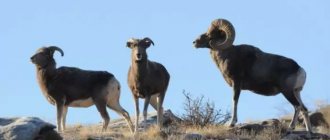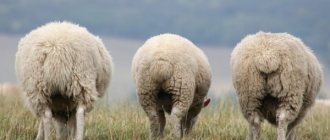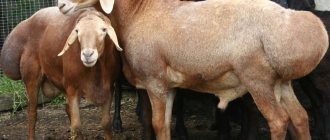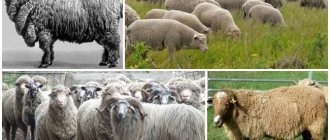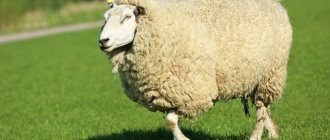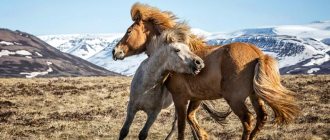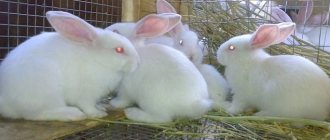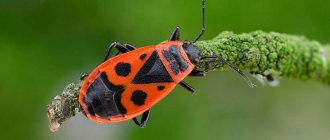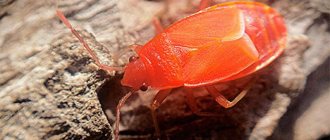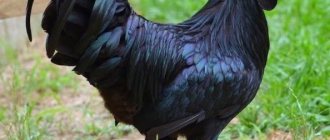The history of the origin of the animal and its name
There are no historically confirmed facts about the exact date of appearance of these artiodactyls. The only thing that can be assumed is that they appeared about 10 thousand years ago. Their ancestors are considered to be mouflons, urials and wild sheep, from which they received the well-known name “ram”. Consequently, rams are domesticated artiodactyls of the sheep genus, a family of gentle animals. Moreover, sheep are representatives of the same genus. But the concepts of “ram” and “sheep” are, first of all, a designation of gender.
The word “ram” has always existed throughout the history of the species. It denoted both wild and domestic animals of both sexes. But the name “sheep” arose much later. The word means a domesticated female ram. And the word “sheep” in the plural includes domestic males and females of the ram family.
For the first time, residents of Asian countries leading a nomadic lifestyle paid attention to hardy and productive animals. But over time, Europeans also began to raise sheep in their settled settlements. Constant selection for the purpose of breeding meat, wool and dairy breeds increased the number to 850, while work on the breeds does not stop to this day.
Mouflon
In people's lives
In the life of modern man, sheep are a source of food and stable income from the sale of wool and other sheep products. For example, ram's horn is used to make decorative figurines or in the interior of the house; sperm and lard are in demand in cosmetology and pharmaceuticals.
But in the 17th century, sheep caused the death of about 30% of the population of England. A description of the events of that time can be found in the lines of the famous work of Thomas More called “Utopia”. It tells about the regime of the formation of capitalism, when peasants were expelled from their lands due to the fact that the sheep of the local bourgeoisie had nowhere to graze.
The influence of sheep on human life can be considered on a psychological level. Everyone knows the method of salvation from insomnia, which consists in counting a given animal.
Monotony in calculations “immerses” a person in a light state of trance and dulls attention, which will help relax the nervous system and quickly fall asleep.
Description and characteristics
The ancestors of domestic sheep are mouflons and urials; they have similar qualities to goats. But since rams got their current appearance thanks to human efforts, it is important to know their most characteristic signs:
- Size – from 50 to 125 cm in height. Length ranges from 60 cm to 1.8 m;
- Weight – from 45 to 200 kg;
- Thick, long coat (curly in most breeds);
- Thick, spiral-like horns (exception: polled breeds);
- Well developed, strong legs with cloven, strong hooves;
- Long tail and white color (wild representatives of the ram family cannot boast of this).
In addition, sheep are herd animals that do not tolerate loneliness or small numbers. At the same time, the same goats feel quite good when paired.
Sheep records
The real record holder for the amount of wool was a ram named Chris, who strayed from his herd and disappeared. He was found by Australian animal activists near Canberra. The missing lamb wandered for 5 years. During this period, he became so overgrown with fur that he was already on the verge of death.
The shorn fleece was 47 cm long and weighed about 40 kg. This fact is an absolute record, because the animal belongs to the Merino breed, which produces only up to 5 kg of fleece per year.
Maintenance and care
Even with a flock of several hundred, there should be no problems with its maintenance. The fact is that unpretentious animals eat many different types of grass, weeds, branches of bushes and trees. Moreover, due to the structure of their jaws and teeth, sheep can nibble grass down to the root. Animals can also go for a long time without drinking and overcome long distances and mountain slopes. They inherited this from their ancestors.
When kept in a closed place or enclosure, only some breeds may require special care; for all others, a dry stall without drafts, and in winter, a warm sheepfold, is sufficient.
Important! In winter, when there is no grass, the diet requires variety. It is necessary to give feed with minerals. At this time, the level of vitamins decreases significantly.
The only vulnerable point of sheep will be sensitivity to moisture and precipitation. Since most breeds have thick and long hair, when wet, animals take a very long time to dry. This can cause illness. In addition, pastures located on mountain slopes, lowlands and in areas of cleared forests will also not be useful for the flock. In such places, humidity and coolness prevail, in which worm larvae develop well, and sheep are very vulnerable to such parasites.
In all other respects, sheep have no equal - they tolerate both heat and cold well thanks to the thermoregulation that wool provides. The animals are peaceful, very obedient and, most importantly, have a good herd instinct, which makes the shepherd’s work easier.
In addition, the herd instinct for the sheep themselves is both an advantage and a disadvantage. The advantage of this quality is that the flock becomes obedient, calm, completely focused on food, and absolutely indifferent to what is happening around them. The downside of this quality is complete confusion and stress if you fall behind the herd.
In predictions
In Kyrgyzstan, lamb is the most popular product. Many rituals and beliefs are associated with it.
- It is believed that during a feast, the more a man eats a lamb bone, the more delicious his future wife will be.
- The shoulder bone of a sheep should not remain intact after a feast. A person who has eaten the meat of this part of the animal must crush the bone. This is because there is a belief that by looking through the fine structure of a given object at the moonlight, you can see your future. So that the evil sorcerer cannot harm the human soul through this attribute, it is broken.
- When a child is born in the house, the father must eat meat from a lamb's neck and hang the bone at the entrance of the house, which will remain there until the baby learns to hold his head up on his own.
- The radius is the guardian of the family hearth, so the man should eat it and hang it above the front door. This ritual will ward off evil spirits and maintain a prosperous relationship between husband and wife.
Did you know? If during the watering process several different flocks mix, then as soon as the shepherd begins to call
“
their
”
sheep, the animals will obediently go to the pasture.
Difference between the words "ram" and "sheep"
Speaking about the difference between the names “ram” and “sheep”, it should be clarified that these concepts have two interpretations:
- The first is a classification of animals (genus), consisting of several species (argali, bighorn sheep and others included in this group, type and class);
- The second is one specific type of sheep, domesticated by humans.
Another interpretation suggests the sheep as a female domesticated animal, giving offspring and milk, and the ram as a male, fertilizing females.
In linguistics
Linguists note that the word “sheep” in the dialects of the Indo-European group has approximately the same sound. This fact is explained by the fact that the domestication of sheep occurred a very long time ago and people in different habitats borrowed the name of the animal from each other, interpreting it to suit their own language.
Important! The word “sheep” has the same root as the Old Slavonic name “aries”, which translates as ram. In Latin this animal is called “ovis”, in the Indian dialect “avika”, in Lithuanian “avis”.
Differences between the sexes
If we consider in detail the narrow understanding of the interpretation of concepts and the differences between a male and a female, you should know the differences in external data:
- Dimensions and weight. A ram will always be larger than a sheep, on average 1.5 times, regardless of the breed;
- Reproductive organs - testicles in rams, udders in sheep;
- The presence of horns - most often only males have them, but there are exceptions when the entire breed is characterized by its polled appearance or horns on both representatives of the genus;
- Character - it manifests itself in males, as they have to win the attention of females or lead the flock.
Nickname based on special appearance criteria
How to distinguish a quail from a quail, the difference between a male and a female
It's time to figure out what a baby sheep and ram is called. Sheep and ram are domestic artiodactyl animals that belong to the bovid family. As you might guess, a mature female of this animal is called a sheep, and a male is called a ram. City dwellers ignorant of agriculture often think that these are different animals. Accordingly, various non-existent animals appear, for example, a female ram or a male sheep.
46Similar
We will have a baby!”: 20 photos of animals that have become happy. 12 animals that drink to the fullest this summer! ))
The concept of “lamb” originates from the Latin “agnus” (young sheep), and the Old Slavonic “lamb” goes back to it. Let's analyze the word according to its composition. The root will be “yagn”, and the diminutive suffix will be “enok”. Everything is simple and logical. It turns out that a lamb is a small lamb or a young ewe.
Purpose of sheep farming
Even in ancient times, when people understood the value of warm sheepskin, tender meat and tasty milk, sheep breeding became a priority in agriculture.
Time has passed, but sheep have not lost their relevance, as they are a universal source of income and products.
Dairy direction
The first thing sheep are popular for is milk. It has a wide range of applications, but it has become most famous as a raw material for the preparation of elite types of cheeses: Roquefort, Pecorino, Caciocavallo, feta cheese and others.
In the course of evolution, the work of breeders and the demand for milk, special dairy breeds were bred: Romanovskaya, Askaniyskaya, East Friesian.
Meat products
Meat takes second place in the value of products from sheep.
Meat from sheep and rams is commonly called “mutton”. It, in turn, is divided into “lamb” - meat products of one-year-old lambs and “lamb” itself - the meat of animals that have reached one year. At the same time, the gender of the animal makes no difference, but it is the meat of young lambs that is in great demand and price - it is more tender, has a rich taste and contains more beneficial properties.
Among the specially bred breeds, the Gorky, Kuibyshev, Latvian, and Dorper are known.
Sheepskin and wool
The priority direction in sheep breeding - the production of sheepskin and wool - over time began to lose its popularity, since processing requires a lot of materials and labor costs. However, its former glory, quality and traditions still keep this industry afloat. And the long-known products made from karakul and tsiga wool cannot replace artificial fabrics and materials.
Among the popular wool breeds, Tsigai, Karakul, and merino occupy a place of honor.
Important! Sheep farming makes a profit not only from females, which increase the number of animals and provide milk, wool and meat. Males, which are one and a half times larger than sheep, produce more meat and wool.
Thus, the relationship between the concepts “sheep” and “ram” has two directions. The first direction is narrow - the name of female and male individuals within the same species of domestic animals, which differ in certain characteristics. The second direction is broad - the unit of classification of an animal species or its membership in a genus.
Benefits of Breeding
A herd of domestic sheep pays for itself very quickly. Feed costs are minimal, sheep grow very quickly, and young animals can be sent to slaughter as early as 7-8 months. From wool breeds you can get several kilograms of wool. Haircuts are carried out twice a year. A sheep farm can start with a few dozen individuals, and after a couple of years the flock will grow to hundreds or even thousands. As in any agricultural business, sheep farming has its pros and cons, but there are still more positive aspects. There are huge benefits from animals; you can get the following types of products:
- meat;
- sheep fat;
- wool;
- skin;
- milk, butter and cheese;
- manure for fertilizer.
How much does a lamb cost? The price largely depends on the breed and purpose of purchase. A live adult sheep for slaughter can be bought for 110-200 rubles per kilogram of live weight. A small young lamb can cost 2000-4000 rubles. It's no secret that the most expensive breeds are Merinos. Elite fine-wool sheep for breeding are sold for several hundred or even thousands of dollars. It is best to buy sheep from specialized farms at the age of 3-4 months.
East Friesian breed
The East Friesian breed comes from Germany. It is universal. It is valued for its meat, lard and wool.
Eastfriesian sheep are large in size. They have a curved nose line and no fleece on their head and thin tail. Long ears point towards the nose. The chest and back are wide, drooping croup. Eastfriesian sheep have well-developed muscles. The coat is painted white.
Sheep of this breed are not distinguished by their endurance and do not tolerate climate change well, but if a purebred sheep is crossed with a local breed that has endurance, it will be possible to increase the level of endurance and acclimatization.
Productivity indicators
The weight of an adult ram is 115 kg. Queens weigh 30 kg less. By 12 months, the Friesian sheep practically reaches its maximum weight, which allows us to classify this breed as early maturing. Daily growth with proper care and quality nutrition exceeds 300 g.
The wool harvest is 6 and 4.5 kg per ram and sheep, respectively. The fleece is short and soft to the touch. The net yield of fleece is 70%. Milk productivity - 650 kg per lactation. Some farmers breed East Friesian sheep specifically to produce milk with a fat content of 6.5%.
What is the name of the cow house?
Shed, shed, -vochek, shed, shed, shed m. shed w. barn, shelter, barn and covered pen for livestock. Cow, calf, sheep barn.
Interesting materials:
How can you train your memory? How can you remove asphalt from shoes? How can I remove the Trust Payment? How can I remove eyebrow lamination? How can you remove cellulite? How can you decorate a wall? How can I enlarge a silicone case? How can I find out the ban period? How can you find out your tax identification number in Russia? How can I find out my Snils number?
grown up lamb - 7 (seven) letters
In a word, in this article we have collected the names of females - mothers, males - fathers, as well as the names of baby animals, including animals (aka mammals), birds, fish, insects, reptiles and amphibians.
Let's look at what a baby sheep is called. Many people living in cities do not even realize that sheep and ram are one type of animal, only female and male. Their baby is not called a ewe or lamb, but a lamb.
Since these representatives of the fauna belong to the order of artiodactyls, their babies are called calves. However, this name was not strongly attached to the offspring of giraffes. They are more often called giraffes or giraffes. But if a child is given the task of describing baby giraffes, then the correct word would be a calf.
Spreading
The first wild sheep were domesticated approximately 6000-7000 years ago in Asia Minor, the Caucasus and Iran. At first they were bred only in mountainous regions, but then it turned out that they easily adapt to a wide variety of conditions, including taking root in arid areas. Sheep gained popularity in the Mediterranean, from where they spread to Western Europe. English colonists brought animals to the USA, South America, Australia and New Zealand.
Countries of practice
Sheep farming is now practiced all over the world. In terms of livestock, China leads (144 million), as well as Australia, India, Iran, New Zealand, Great Britain, South Africa, Turkey, Pakistan, and Spain.
Interesting Facts:
- Sheep are used in a variety of ways in the household. They are a source of meat, fat, milk, wool, lanolin, fur and hides. Most breeds are not highly specialized; they are used to produce several products at once, which is very convenient.
- Sheep are even used in scientific experiments. The most famous representative of this species is Dolly the sheep, which became the world's first cloned mammal.
- Sheep milk is popular in Israel, the Caucasus, and the Mediterranean. At first it was valued on a par with meat and bread. But then it gave way to cow’s milk, but the production of sheep cheese based on it remains unique. The most famous among them are feta cheese, Roquefort and feta.
Behavior
Sheep are healthy and hardy animals. They are unpretentious, easy to manage, they are not aggressive, compact, and are not afraid of cold weather. In warm countries, sheep can be kept on pastures all year round; in moderately cold winters, sheds or uninsulated sheds are enough for them. But sheep do not tolerate dampness well, and therefore they are practically not bred in the humid tropics. The disadvantages of sheep are their lack of intelligence, lack of curiosity, and lack of contact. They slowly get used to a new environment and find it difficult to change habits, which leads to animals being considered stubborn. In addition, they have a very strong herd instinct, and sheep can only be kept in large groups. Sheep are sensitive to loud noises and are afraid of the dark and confined spaces. But the listed disadvantages of sheep behavior can also become their advantages. Thus, one shepherd can cope with a herd of thousands of sheep, controlling one leading animal; the herd can even be left without supervision. If you tie one ram, the rest of the herd will remain nearby and will not go anywhere.
Training and features
It is difficult to train sheep, but they can master several commands and remember the shepherds. They are meek, flexible, and have a good disposition. Compared to goats, sheep have a rougher voice and less agility. They do not climb steep slopes and slopes, and do not jump high.
Reproduction
Most sheep breeds are very fertile. They reach sexual maturity at six months, but they reproduce from the age of 1.5 years. Different breeds produce offspring either all year round or seasonally. The duration of pregnancy is 142-155 days. There are usually 1-2 lambs in a litter, sometimes up to 3-5. At the age of 2 weeks they try grass, and at about six months they become independent. Lambs are very active and playful, running around the pastures and constantly jumping up and down. Sheep are used on the farm for up to 6-7 years. The maximum life expectancy is 15-18 years.
